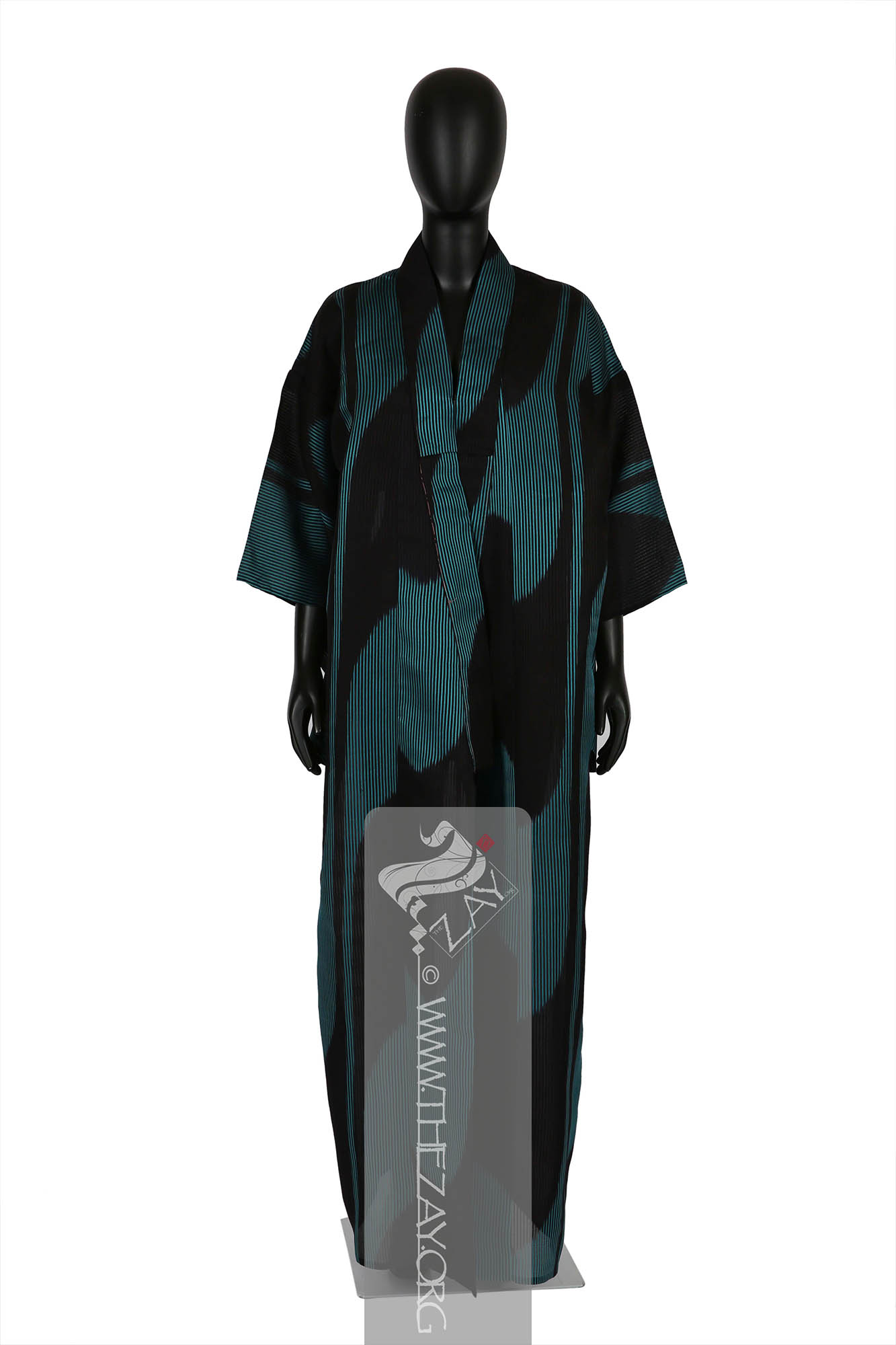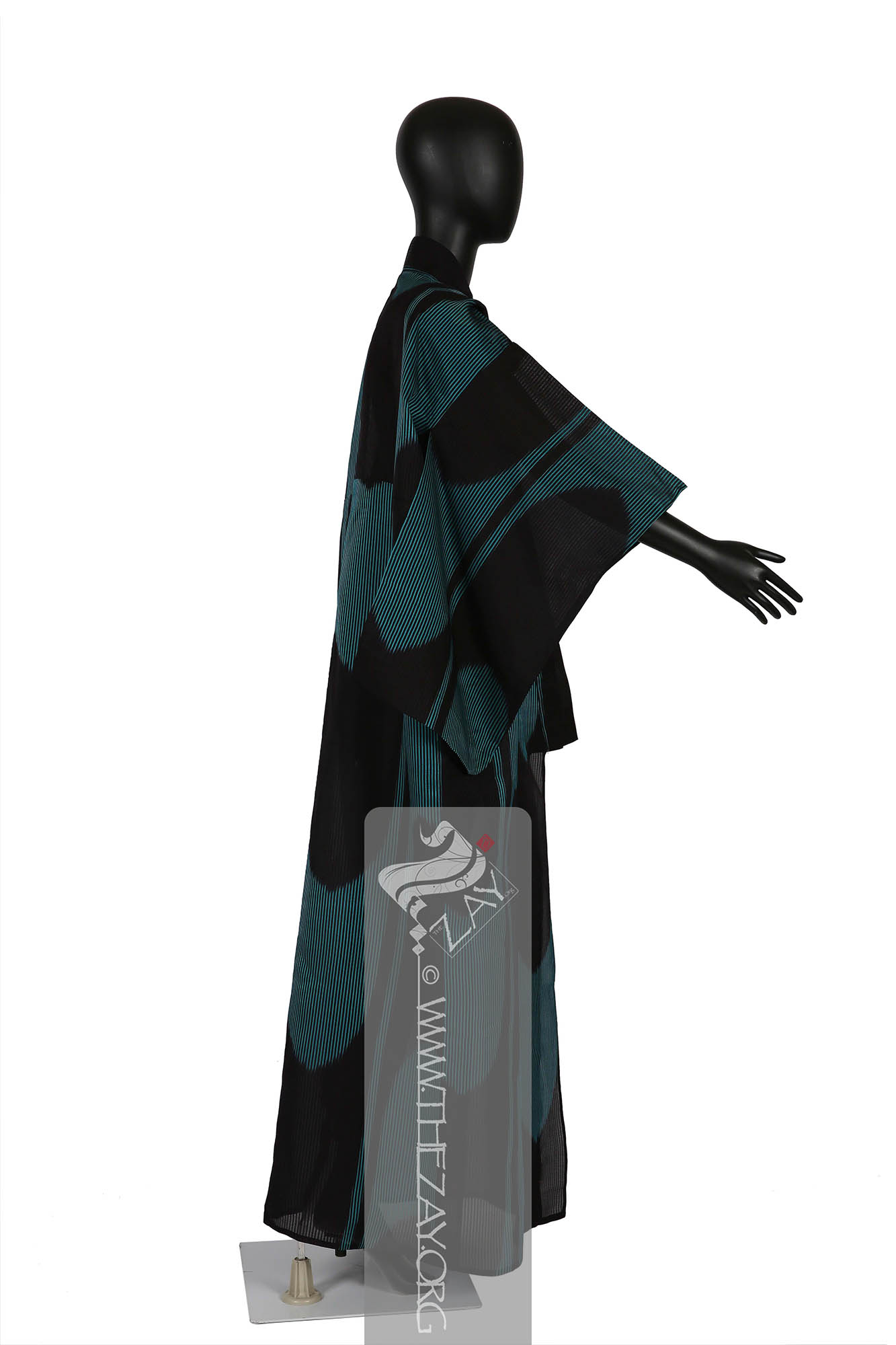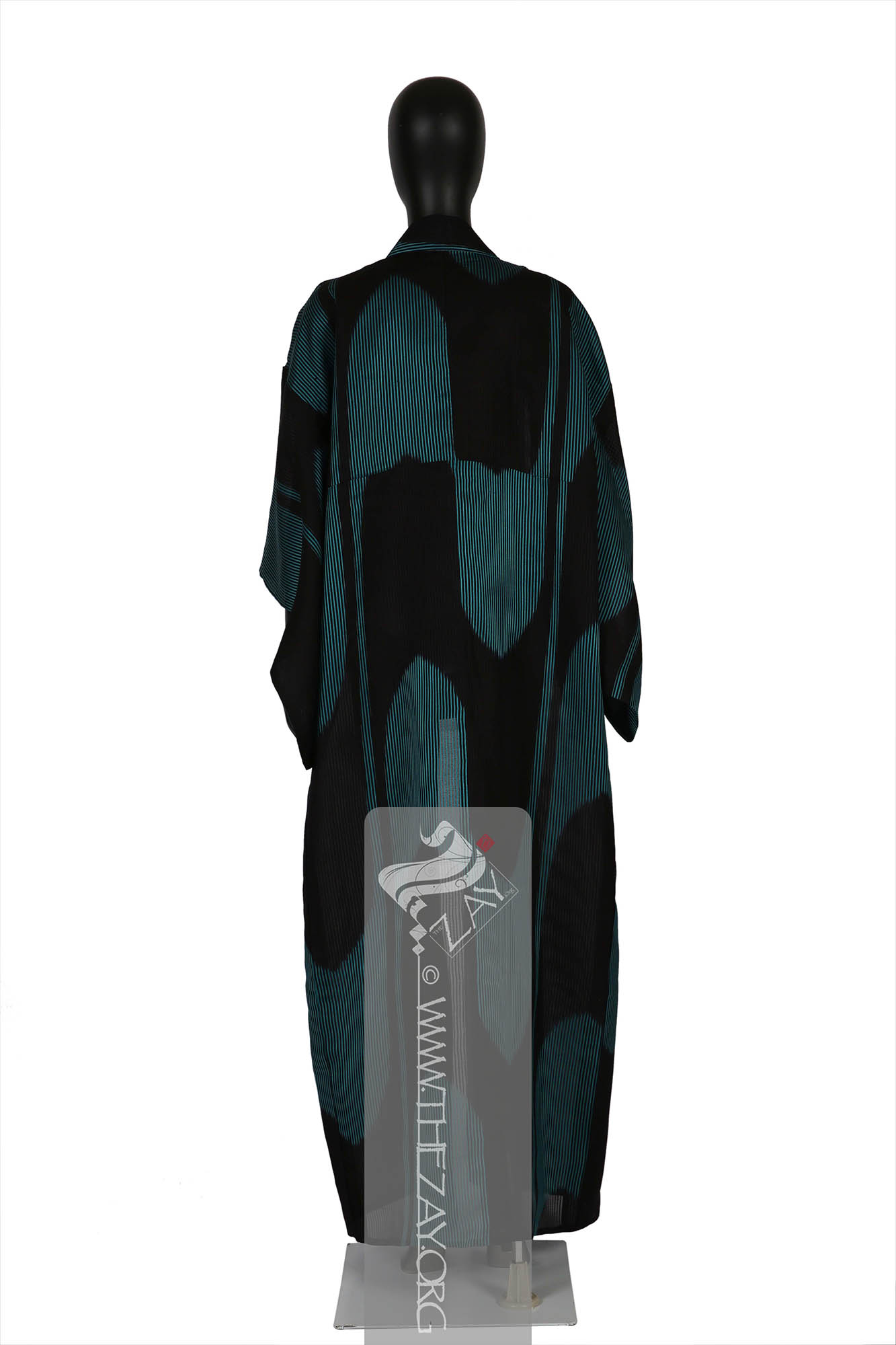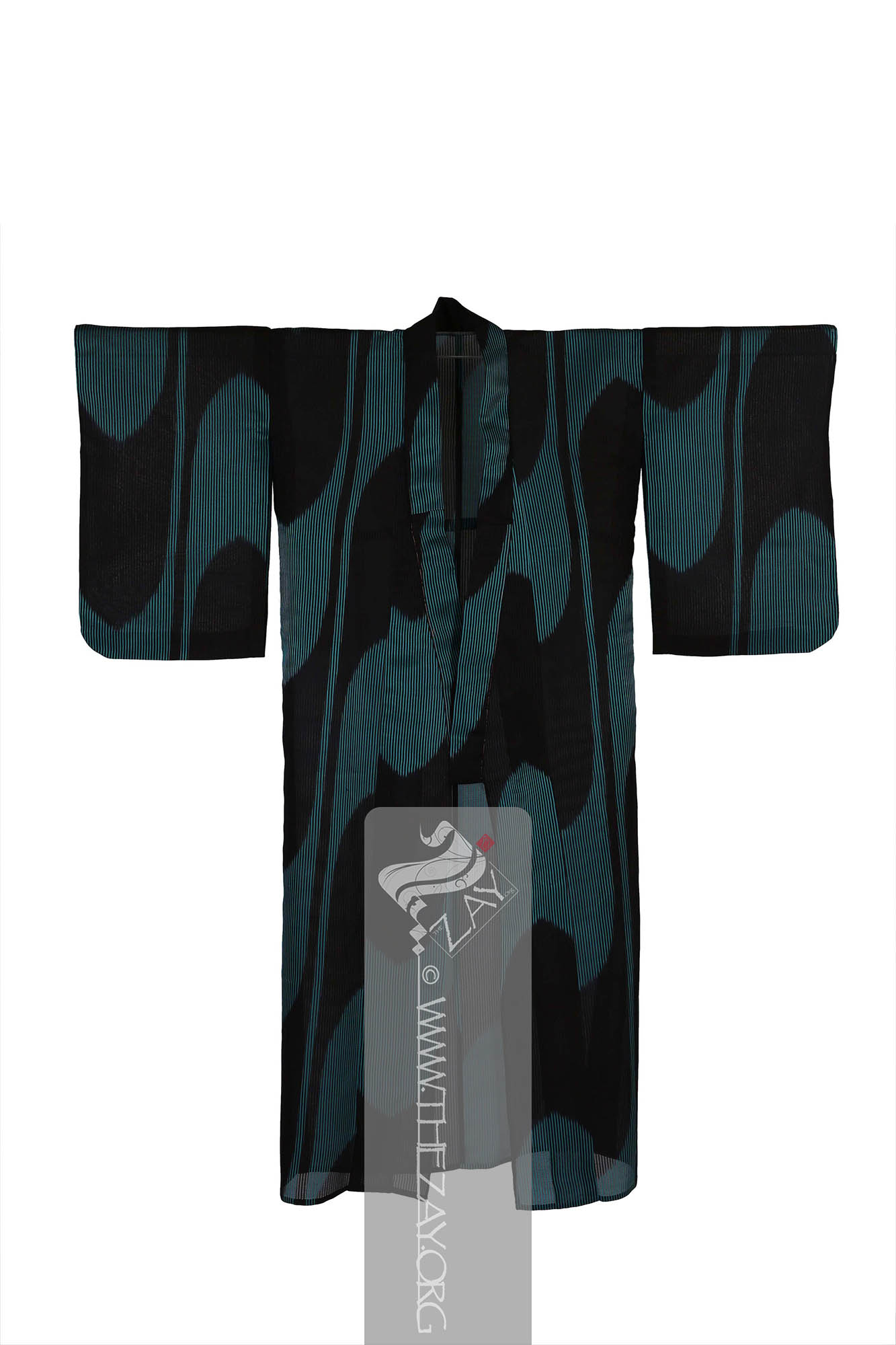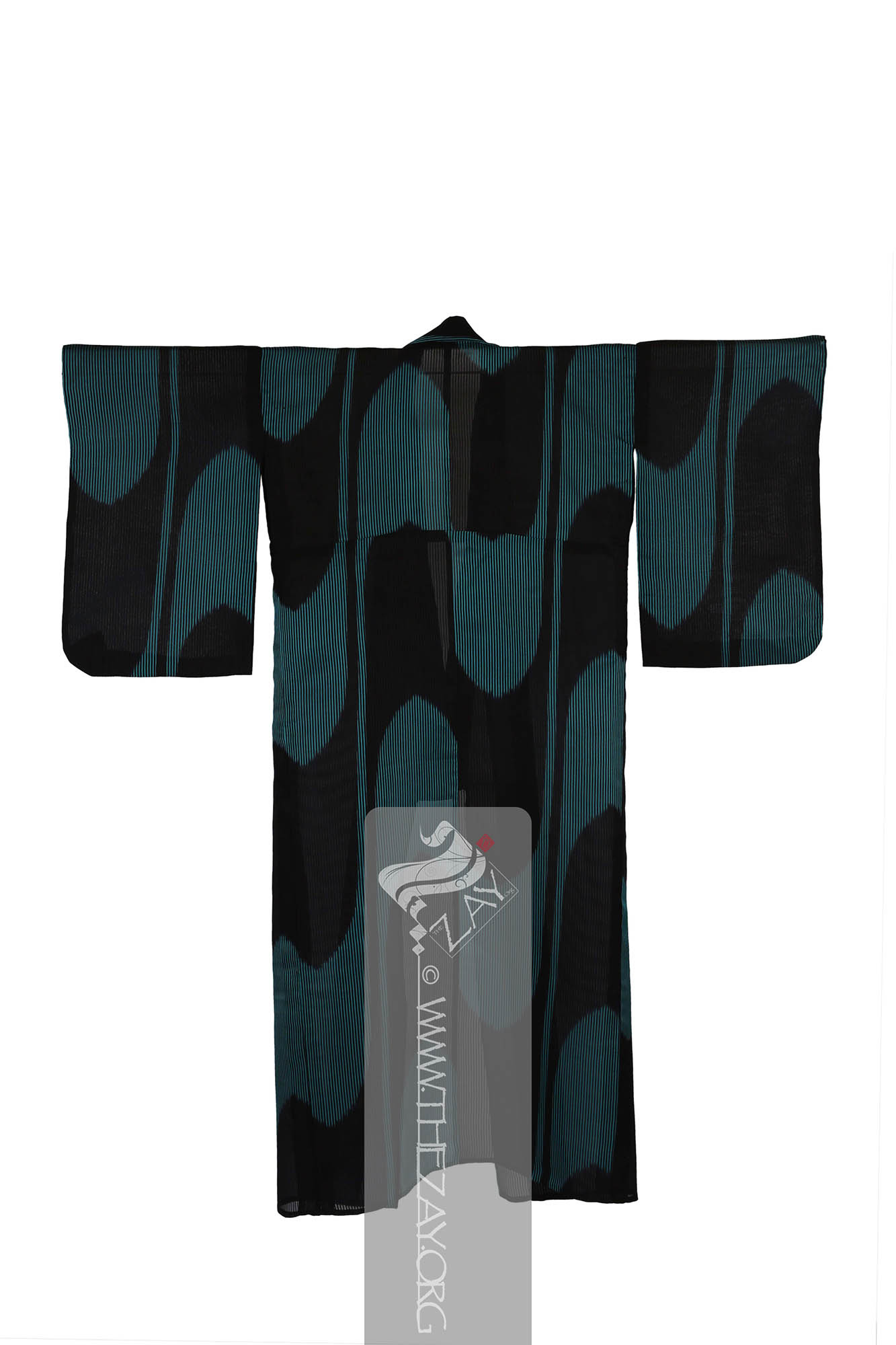Object History This vibrant blue and black (gauze
Gauze: (English), very fine wire mesh transparent fabric of silk, linen, or cotton.) (yukata_kimono
Yukata_kimono: (Japanese: Bathrobe), a traditional Japanese summer kimono worn by both men and women. Characterised by its material which is usually summer friendly cotton, contumely white or dyed in indigo and never lined. traditionally worn all year long as bathrobes. ) was purchased by Dr. Reem Tariq
Ṭariq: (Arabic; Synonym: tulle_bi_talli; talli; badla; khus_dozi ), series of small metal knots made on a woven net ground as embellishment. The term is commonly used in the Levant Arab region specifically in Lebanon.
El Mutwalli
Dr. Reem Tariq
Ṭariq: (Arabic; Synonym: tulle_bi_talli; talli; badla; khus_dozi ), series of small metal knots made on a woven net ground as embellishment. The term is commonly used in the Levant Arab region specifically in Lebanon.
el Mutwallī: Founder (CEO) of the Zay
Zay: (Arabic: costume, Pl. azyaā’), a set of clothes in a style typical of a particular country or historical period. Initiative, a public figure, speaker and author. An expert curator and consultant in Islamic art and architecture, interior design, historic costume, and UAE heritage. in 2017 from a dealer in New York to enhance the collection of The Zay
Zay: (Arabic: costume, Pl. azyaā’), a set of clothes in a style typical of a particular country or historical period. Initiative. Object Features This is a women’s summer yukata_kimono
Yukata_kimono: (Japanese: Bathrobe), a traditional Japanese summer kimono worn by both men and women. Characterised by its material which is usually summer friendly cotton, contumely white or dyed in indigo and never lined. traditionally worn all year long as bathrobes. with woven design. The previous collector describes the material as “synthetic”. Although there are doubts about the nature of its material, it is however made of a very stiff gauze
Gauze: (English), very fine wire mesh transparent fabric of silk, linen, or cotton. weave in black, most likely (sha
Sha: It is a gauze like sheer silk fabric characterised by its crispness. It is often used to make unlined summer, generally informal, kimonos. ). The field of the yukata_kimono
Yukata_kimono: (Japanese: Bathrobe), a traditional Japanese summer kimono worn by both men and women. Characterised by its material which is usually summer friendly cotton, contumely white or dyed in indigo and never lined. traditionally worn all year long as bathrobes. is decorated with a wavy pattern that runs smoothly all across the piece in coordinated harmony. This pattern is acquired with a superimposed blue silk floss
Floss: (Old French: flosche – nap of velvet), is a type of silk fibre obtained from the cocoons of wild silkworms. It is characterized by its long, fluffy fibers that are not tightly woven, making it ideal for use in various textile applications such as embroidery, lace-making, and sewing. like thread in (ikat
Ikat: (Indonesian and Malay: Chord, thread, bundle; Synonym: atlas
Atlas: (Arabic and Aramaic: atlas – silk; from Greek: Atlas – Character from Greek mythology Synonym: adras, ikat, abr), a resist dyeing technique that involves tying and dyeing yarns or threads before weaving, resulting in a distinct pattern. With strong traditions sporadically across the globe it probably originated independently around the world. , adras
Adras: (Arabic and Aramaic: atlas
Atlas: (Arabic and Aramaic: atlas – silk; from Greek: Atlas – Character from Greek mythology Synonym: adras, ikat, abr), a resist dyeing technique that involves tying and dyeing yarns or threads before weaving, resulting in a distinct pattern. With strong traditions sporadically across the globe it probably originated independently around the world. – silk; from Greek: Atlas
Atlas: (Arabic and Aramaic: atlas – silk; from Greek: Atlas – Character from Greek mythology Synonym: adras, ikat, abr), a resist dyeing technique that involves tying and dyeing yarns or threads before weaving, resulting in a distinct pattern. With strong traditions sporadically across the globe it probably originated independently around the world. – Character from Greek mythology Synonym: atlas
Atlas: (Arabic and Aramaic: atlas – silk; from Greek: Atlas – Character from Greek mythology Synonym: adras, ikat, abr), a resist dyeing technique that involves tying and dyeing yarns or threads before weaving, resulting in a distinct pattern. With strong traditions sporadically across the globe it probably originated independently around the world. , ikat, abr), a resist dyeing technique that involves tying and dyeing yarns or threads before weaving, resulting in a distinct pattern. With strong traditions sporadically across the globe it probably originated independently around the world. ), is a resist dyeing technique that involves tying and dyeing yarns or threads before weaving, resulting in a distinct pattern. With strong traditions in Southeast Asia, Central Asia, the Indian subcontinent and Central America it probably originated independently around the world. ) style. From a distance the piece also gives an illusion of a (quadrille
Quadrille: (Latin: quadrum – square) Quadrille fabric is a type of lightweight cotton or linen fabric, woven with a checked or plaid pattern in contrasting colours. It is commonly used for clothing, drapery, and upholstery.
) fabric. With no lining this piece is very sheer and light weight which suggests that it was made to use during the summer months. Though The
Zay
Zay: (Arabic: costume, Pl. azyaā’), a set of clothes in a style typical of a particular country or historical period. Initiative is concerned mainly with the dress and adornment heritage of the Arab world, it does include in its collection articles from areas outside the region. These tend to be collected to illustrate specific shared elements and influences attesting that the Arab world never existed in a vacuum. It constantly drew, and continues to draw, inspiration and influences from the cultures it comes in contact with be it through trade or geopolitical circumstances, especially those countries within the old silk route.
Therefore, one cannot but draw parallels between many techniques used in such garments, such as (
couching
Couching: (Latin: collocare – Place together), in needlework and embroidery couching is a technique in which yarn or other materials are laid across the surface of the ground fabric and fastened in place with small stitches of the same or a different yarn
) and thread knotting techniques (
macrame
Macrame: (French: macramé – A hand-knotted textile from Turkish: makrama – table spread or towel, from Arabic: miqrama – bedspread possibly with knotted hanging fringes resembling dangling grapes or karam in Arabic) A form of textile or fringe made by a knotting cord in geometrical patterns possibly originating in Babylon and Assyria.Macrame
Macrame: (French: macramé – A hand-knotted textile from Turkish: makrama – table spread or towel, from Arabic: miqrama – bedspread possibly with knotted hanging fringes resembling dangling grapes or karam in Arabic) A form of textile or fringe made by a knotting cord in geometrical patterns possibly originating in Babylon and Assyria.: makrəˌmā: (Arabic: karam: tree with dangling grapes), ornamental fringe. The art of knotting cord or string in patterns to make decorative articles. Earliest recorded uses of macramé-style knots as decoration appeared in Babylonian and Assyrian carvings.), or flat metal adornment (
talli
Tallī: (Turkish: tel – wire, string), Gulf Arab – a woven braided trimming made with metal wire, threads and ribbons often sewn on detachable panels used as embellishments. Other – (Synonym: tulle_bi_talli
Tūlle_bi_tallī: (French: Tulle – a city in France where fine material for veil was first made; Turkish: tel – wire; Synonym: tariq; talli; badla; khus_dozi
Khus_dozi: (Persian: Khvosh – an Iranian province; dozi – needlework; Synonym: tariq; talli; tulle_bi_talli; badla), series of small metal knots made on a woven net ground as embellishment. The term is commonly used in Iran and parts of the Arabian Peninsula possibly because Khvosh was one of the centres for the craft.
), series of small metal knots made on a woven net ground as embellishment. The term is commonly used in the North African Arab region specifically in Egypt.
; tariq; badla; khus_dozi
Khus_dozi: (Persian: Khvosh – an Iranian province; dozi – needlework; Synonym: tariq; talli; tulle_bi_talli; badla), series of small metal knots made on a woven net ground as embellishment. The term is commonly used in Iran and parts of the Arabian Peninsula possibly because Khvosh was one of the centres for the craft.
), series of small metal knots made on a woven net ground as embellishment.
), that are quite similar to those found in different parts of the Arab region.
The
kimono
Kimono: (Japanese: ki : wearing, mono: thing, Singular: Kimono) A traditional Japanese long loose robe with wide sleeves tied with a sash around the waist. Presently it is the national dress of Japan. , in particular, displays similarities that can be drawn with the pattern of Arab women’s overgarment or the (
thawb
Thawb: (Arabic: thawb, Pl. Athwāb/thībān), can be pronounced thobe
Thobe: (Arabic: thawb, Pl. Athwāb/thībān), can be pronounced thawb or tobe
Tobe: (Arabic: thawb, Pl. Athwāb/thībān), can be pronounced thawb or thobe based on locale. The standard Arabic word for ‘fabric’ or ‘garment’. It can refer to a qamīs-like tunic worn by men and women in the Arabian Peninsula, Iraq, the southern and south-western ports and islands of Iran, and some countries in East and West Africa. More specifically, it can refer to the square-shaped Bedouin overgarment worn by women. based on locale. The standard Arabic word for ‘fabric’ or ‘garment’. It can also refer to a qamīs-like tunic worn by men and women in the Arabian Peninsula, Iraq, the southern and south-western ports and islands of Iran, and some countries in East and West Africa. More specifically, it can refer to the square-shaped Bedouin overgarment worn by women. or tobe
Tobe: (Arabic: thawb, Pl. Athwāb/thībān), can be pronounced thawb or thobe based on locale. The standard Arabic word for ‘fabric’ or ‘garment’. It can refer to a qamīs-like tunic worn by men and women in the Arabian Peninsula, Iraq, the southern and south-western ports and islands of Iran, and some countries in East and West Africa. More specifically, it can refer to the square-shaped Bedouin overgarment worn by women. based on locale. The standard Arabic word for ‘fabric’ or ‘garment’. It can also refer to a qamīs-like tunic worn by men and women in the Arabian Peninsula, Iraq, the southern and south-western ports and islands of Iran, and some countries in East and West Africa. More specifically, it can refer to the square-shaped Bedouin overgarment worn by women in the Arabian Gulf region. ), common to the Gulf region, constructed of three uncut panels of broad clothes forming the central body panel and the side sleeve panels very similar in shape to the
kimono
Kimono: (Japanese: ki : wearing, mono: thing, Singular: Kimono) A traditional Japanese long loose robe with wide sleeves tied with a sash around the waist. Presently it is the national dress of Japan. .
Links
- Morishima, Yuki, et al. Kimono
Kimono: (Japanese: ki : wearing, mono: thing, Singular: Kimono) A traditional Japanese long loose robe with wide sleeves tied with a sash around the waist. Presently it is the national dress of Japan. Refashioned: Japan’s Impact on International Fashion. USA, Asian Art Museum, 2018.
- Kahlenberg, Mary Hunt. Asian Costumes and Textiles: From the Bosphorus to Fujiama. Italy, Skira, 2001.
- Liddell, Jill. The Story of the Kimono
Kimono: (Japanese: ki : wearing, mono: thing, Singular: Kimono) A traditional Japanese long loose robe with wide sleeves tied with a sash around the waist. Presently it is the national dress of Japan. . USA, E P Dutton, 1989.
- Dalby, Liza Crihfield. Kimono
Kimono: (Japanese: ki : wearing, mono: thing, Singular: Kimono) A traditional Japanese long loose robe with wide sleeves tied with a sash around the waist. Presently it is the national dress of Japan. : Fashioning Culture. Reaktion Books, 1993.
- Gluckman, Dale Carolyn and Sharon Sadako Takeda. When Art Became Fashion: Kosode
Kosode: (Japanese: small sleeve or opening), a traditional Japanese inner robe for both genders. Similar to a kimono but with a wider body, longer collars, and narrower and rounded sleeves, often stitched to the body, these under robes were lavishly decorated and were worn on top from late 16th century. in Edo-Period Japan. Los Angeles County Museum of Art, 1996.
- Kimono
Kimono: (Japanese: ki : wearing, mono: thing, Singular: Kimono) A traditional Japanese long loose robe with wide sleeves tied with a sash around the waist. Presently it is the national dress of Japan. : Kyoto to Catwalk. 27 Aug. – 25 Oct. 2020, V&A South Kensington, London https://www.vam.ac.uk/exhibitions/kimono
Kimono: (Japanese: ki : wearing, mono: thing, Singular: Kimono) A traditional Japanese long loose robe with wide sleeves tied with a sash around the waist. Presently it is the national dress of Japan. -kyoto-to-catwalk
- Gluckman, Dale Carolyn. “Liza Dalby. Kimono
Kimono: (Japanese: ki : wearing, mono: thing, Singular: Kimono) A traditional Japanese long loose robe with wide sleeves tied with a sash around the waist. Presently it is the national dress of Japan. : Fashioning Culture.:Kimono
Kimono: (Japanese: ki : wearing, mono: thing, Singular: Kimono) A traditional Japanese long loose robe with wide sleeves tied with a sash around the waist. Presently it is the national dress of Japan. : Fashioning Culture.” Museum Anthropology, vol. 19, no. 1, Mar. 1995, pp. 79–81. Crossref, https://doi.org/10.1525/mua.1995.19.1.79
- “Meisen Kimono
Kimono: (Japanese: ki : wearing, mono: thing, Singular: Kimono) A traditional Japanese long loose robe with wide sleeves tied with a sash around the waist. Presently it is the national dress of Japan. From HALI 184 - HALI.” HALI, 24 July 2015, hali.com/news/meisen-kimono
Kimono: (Japanese: ki : wearing, mono: thing, Singular: Kimono) A traditional Japanese long loose robe with wide sleeves tied with a sash around the waist. Presently it is the national dress of Japan. .
- Kimono
Kimono: (Japanese: ki : wearing, mono: thing, Singular: Kimono) A traditional Japanese long loose robe with wide sleeves tied with a sash around the waist. Presently it is the national dress of Japan. Style: Edo Traditions to Modern Design: The John C. Weber Collection. USA, Met Publications, www.metmuseum.org/art/metpublications/Kimono_Style
- Richard, Naomi Noble. “Nō Motifs in the Decoration of a Mid-Edo Period Kosode
Kosode: (Japanese: small sleeve or opening), a traditional Japanese inner robe for both genders. Similar to a kimono but with a wider body, longer collars, and narrower and rounded sleeves, often stitched to the body, these under robes were lavishly decorated and were worn on top from late 16th century. .” Metropolitan Museum Journal, vol. 25, 1990, pp. 175–83. JSTOR, https://doi.org/10.2307/1512899. Accessed 10 May 2023.
- Kramer, Elizabeth. “Review of ‘Kimono
Kimono: (Japanese: ki : wearing, mono: thing, Singular: Kimono) A traditional Japanese long loose robe with wide sleeves tied with a sash around the waist. Presently it is the national dress of Japan. : A Modern History.’” Reviews in History, School of Advanced Study, 2015. Crossref, https://doi.org/10.14296/rih/2014/1787.




